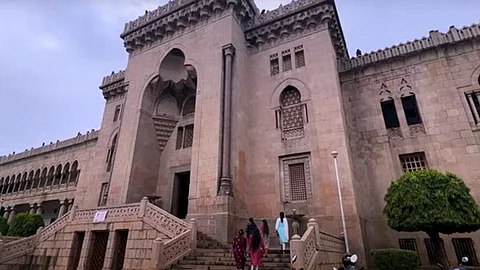

The Osmania University in Hyderabad, which served as the prime venue for the Telangana statehood struggle, has imposed restrictions on student protests, sparking outrage from the opposition Bharat Rashtra Samithi (BRS) and the general public.
OU has been a cornerstone of the Telangana statehood agitation, with many of its present and former students playing a major role in the movement.
A circular issued by the university’s Registrar on March 13 stated that staging agitations and dharnas on university premises was prohibited and warned of “serious action” against violators. The circular cited concerns over disruptions to administrative functions and the university’s public image, asserting that recent student demonstrations had affected operations.
“In recent times, it is observed that there are several incidents of students/student groups…entering the Departments/Colleges Centres/Administrative Building…staging demonstrations and dharnas resulting in disruption of the administrative work and giving [a] wrong perception of the University to society,” the circular read. It also barred activities such as slogan-raising, preventing university authorities from carrying out their duties, and using derogatory language against university staff.
However, following widespread criticism, the university issued a clarification on March 16, claiming that there was no “blanket ban” on protests. Instead, students were encouraged to raise their concerns “through well-established and structured mechanisms,” the statement said. The Registrar defended the curbs, stating they were necessary to prevent disruptions to academic and administrative functions, which could hinder the university’s efforts to secure national and international accreditations.
BRS working president KT Rama Rao (KTR) strongly condemned the decision, calling it a direct attack on democracy. He accused the ruling Congress government of hypocrisy, questioning whether this move aligned with the democratic values it had championed before coming to power.
“Is this the democratic right of protest that Rahul Gandhi and the Congress claimed to uphold? If Congress truly believed in democracy, why is it resorting to authoritarian measures to silence student voices?” KTR asked.
The BRS leader also reminded the public that the Congress had promised the right to protest as part of its ‘Seventh Guarantee’ during its election campaign.
“Suppressing student voices is a clear symbol of dictatorship. The Congress government in Telangana is now revealing its true colors by curbing students’ fundamental right to protest. Osmania University, which played a crucial role in the Telangana movement, is now being turned into a prison under this oppressive rule,” he alleged.
However, under the previous K Chandrasekhar Rao-led government too, OU saw a clampdown on dissent, with students resenting the BRS administration over employment.
OU had also imposed restrictions on political activities during KCR’s tenure. In 2022, Rahul Gandhi was denied permission to visit the campus, prompting criticism that the then-BRS government was trying to suppress dissent.
In 2023, when OU slipped 14 places in the National Institutional Ranking Framework (NIRF), the university blamed it on the lack of recruitment under nine years of BRS rule, with not a single vacancy being filled in this period.
Amidst the controversy, the university administration maintained that its decision was not aimed at stifling free speech. “These measures have been introduced solely to safeguard the university’s academic integrity, administrative efficiency, and security. At no point is the university attempting to stifle free speech or curtail democratic expression,” the Registrar stated in response to criticism.
(With IANS inputs)